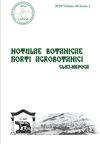Assessment of herbaceous vegetation classification using orthophotos produced from the image acquired with unmanned aerial systems
IF 1.3
4区 生物学
Q3 PLANT SCIENCES
引用次数: 0
Abstract
Arguably the most popular remote-sensing products are classified images. However, there are no definitive procedures to assess classification accuracy that simultaneously consider resources available and field efforts. The explosive usage of unmanned aerial systems (UAS) in land surveys adds new challenges to classification assessment, as orthorectified images usually contain significant artifacts. This study aims to identify the optimal ratio between training and validation sample size within a supervised classification approach applied to UAS orthophotos. As a case study, we used a wetland area west of Portland, OR, USA, treated with various glyphosate formulations to control Phalaris arundinacea, commonly known as reed canary grass. A completely randomized design with five replications and six glyphosate formulations was used to assess P. arundinacea vigor following repeated herbicide applications. The change in P. arundinacea vitality was monitored with high-resolution four-band imagery acquired with a SlantRange 3PX camera installed on a DJI Matrice 210. The orthophotos created from images were produced with Pix4D, which was subsequently preprocessed with ERDAS Imagine 2020 to reduce the noise, shadows, and artifacts. All images were classified with the maximum likelihood classification algorithm. Simple random and stratified random sampling methods were applied to collect training and validation samples, evaluating eight ratios of training to validation samples to assess their classification accuracy. We found that increasing the training-to-validation sample size ratio enhances accuracy, with the 3:1 ratio being the most reliable in classifying P. arundinacea vigor. Our study provides evidence that image preprocessing and enhancement are essential for UAS-based imagery.利用无人机系统获取的图像生成的正射影像评估草本植被分类
可以说,最受欢迎的遥感产品是分类图像。然而,目前还没有确定的程序来评估同时考虑到现有资源和实地工作的分类准确性。无人机系统(UAS)在土地调查中的爆炸性使用给分类评估带来了新的挑战,因为正射影图像通常包含重要的伪影。本研究旨在确定用于UAS正射影像的监督分类方法中训练样本和验证样本的最佳比例。作为一个案例研究,我们使用了美国俄勒冈州波特兰西部的一个湿地区域,用各种草甘膦配方处理以控制蝴蝶兰,俗称芦苇金丝雀草。采用5个重复、6个草甘膦配方的完全随机设计,对反复施用草甘膦后的马齿苋活力进行了评价。采用安装在DJI Matrice 210上的SlantRange 3PX相机获取的高分辨率四波段图像监测黄颡虾活力的变化。由图像创建的正射影像是用Pix4D生成的,随后用ERDAS Imagine 2020进行预处理,以减少噪声、阴影和伪影。使用最大似然分类算法对所有图像进行分类。采用简单随机和分层随机抽样的方法收集训练样本和验证样本,对训练样本和验证样本的8个比率进行评估,以评估其分类准确率。我们发现,增加训练样本与验证样本的比例可以提高准确率,其中3:1的比例是最可靠的。我们的研究提供了图像预处理和增强对基于无人机的图像至关重要的证据。
本文章由计算机程序翻译,如有差异,请以英文原文为准。
求助全文
约1分钟内获得全文
求助全文
来源期刊

Notulae Botanicae Horti Agrobotanici Cluj-napoca
PLANT SCIENCES-
CiteScore
2.70
自引率
0.00%
发文量
118
审稿时长
3 months
期刊介绍:
Notulae Botanicae Horti Agrobotanici Cluj-Napoca is a peer-reviewed biannual journal aimed at disseminating significant research and original papers, critical reviews and short reviews. The subjects refer on plant biodiversity, genetics and plant breeding, development of new methodologies that can be of interest to a wide audience of plant scientists in all areas of plant biology, agriculture, horticulture and forestry. The journal encourages authors to frame their research questions and discuss their results in terms of the major questions of plant sciences, thereby maximizing the impact and value of their research, and thus in favor of spreading their studies outcome. The papers must be of potential interest to a significant number of scientists and, if specific to a local situation, must be relevant to a wide body of knowledge in life sciences. Articles should make a significant contribution to the advancement of knowledge or toward a better understanding of existing biological and agricultural concepts. An international Editorial Board advises the journal. The total content of the journal may be used for educational, non-profit purposes without regard to copyright. The distribution of the material is encouraged with the condition that the authors and the source (Notulae Botanicae Horti Agrobotanici Cluj-Napoca or JCR abbrev. title Not Bot Horti Agrobo) are mentioned.
 求助内容:
求助内容: 应助结果提醒方式:
应助结果提醒方式:


